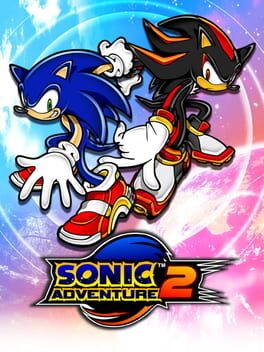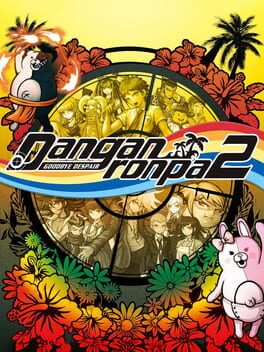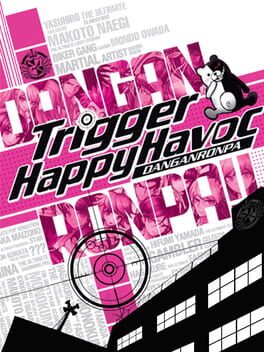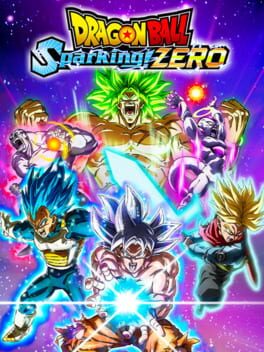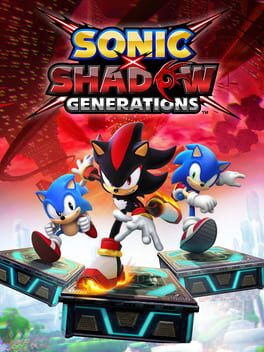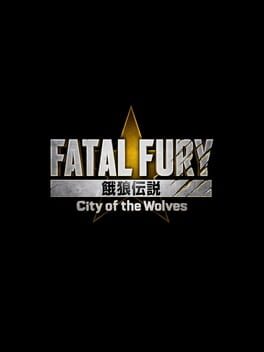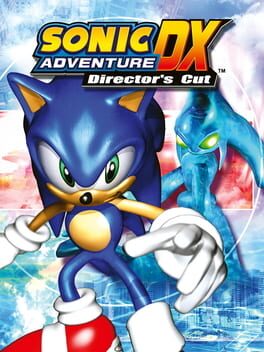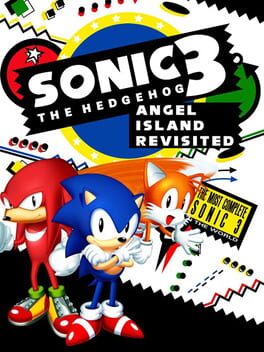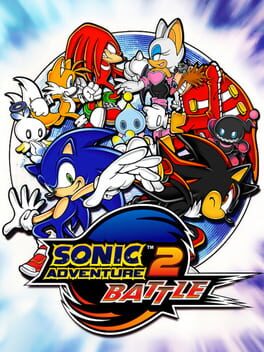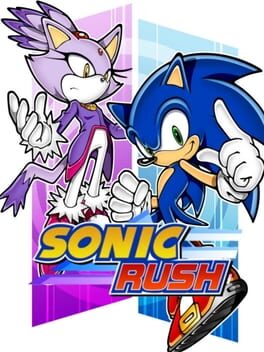wolvestar
8 reviews liked by wolvestar
Sonic Adventure 2
2001
eu tenho sentimentos muito pessoais com esse jogo. cada minuto nas suas fases com level design bem maneiro e ritmo agitado, me jogam pro passado como uma máquina do tempo e me sinto mais conectado com seus personagens, mas sinto que nessa rejogada foi diferente.
se revelaram novas nuances tanto na sua história quanto em todo seu game design, e tudo veio com um gosto mais otimista e um sentimento mais tranquilo e acolhedor.
explorar novamente essa aventura, agora mais velho, me revelou camadas que eu jamais imaginei que esse jogo tinha, mas sem deixar de lado aquela energia maluca que me movia quando mais novo. ganhou mais espaço no meu coração e tornou-se um dos meus favoritos do ouriço azul.
no fim, nunca esquecer da máxima: viva e aprenda
se revelaram novas nuances tanto na sua história quanto em todo seu game design, e tudo veio com um gosto mais otimista e um sentimento mais tranquilo e acolhedor.
explorar novamente essa aventura, agora mais velho, me revelou camadas que eu jamais imaginei que esse jogo tinha, mas sem deixar de lado aquela energia maluca que me movia quando mais novo. ganhou mais espaço no meu coração e tornou-se um dos meus favoritos do ouriço azul.
no fim, nunca esquecer da máxima: viva e aprenda
Alan Wake
2010
Após Lenz ter dado incríveis duas estrelas pra este jogo tão importante pra mim, eu reagi da única maneira amigável que eu poderia
Transmiti o jogo inteiro explicando tudinho o que ele tem de especial, para que Lenz passasse a entender. Uma verdadeira aula sobre Alan Wake
Masterclass de Alan Wake, por Gomez
Lenz subiu sua nota de duas, para três estrelas
Isso é o que eu estou disposto a fazer por Alan Wake
Transmiti o jogo inteiro explicando tudinho o que ele tem de especial, para que Lenz passasse a entender. Uma verdadeira aula sobre Alan Wake
Masterclass de Alan Wake, por Gomez
Lenz subiu sua nota de duas, para três estrelas
Isso é o que eu estou disposto a fazer por Alan Wake
Nunca na minha vida achei que fosse possível um Danganronpa entrar na minha “seleta” lista de jogos que considero um 10/10, mas chegar a essa conclusão antes de ter jogado o V3 foi um enorme equívoco da minha parte. Pois, na minha opinião, Danganronpa V3: Killing Harmony pega tudo de bom que tem na franquia e eleva à quarta ou quinta potência, criando um produto tão bom, mas tão bom que ainda não consigo crer que pertence a mesma franquia de jogos como Trigger Happy Havoc e Ultra Despair Girls.
De início, ele até aparenta ser mais do mesmo: 16 Ultimates presos em um colégio sendo forçados a se matarem e provarem as suas inocências. Entretando, já na primeira cena do jogo é possível ver que a pegada aqui será diferente. O foco é muito menos esse “jogo do abate” e sim a circunstância, a realidade, o “como?” e o “por quê?”. Vemos os dois personagens principais, a pianista Kaede e o detetive Shuichi, sendo presos em um armário, com a crença de que são alunos comuns e que foram sequestrados, mas pouco tempo depois, graças a uma “Flashback Light”, eles lembram quem eles verdadeiramente são: Ultimates.
Logo de cara o jogador já fica com diversas dúvidas, será que eles realmente são ultimates? As memórias que eles têm são deles mesmos ou foram implantadas? Por que eles foram sequestrados? Como que nenhum deles tinha lembranças disso tudo quando acordaram? Garanto que elas todas são resolvidas no decorrer da gameplay, mas só o fato do jogo conseguir brincar com as emoções do player, fazê-lo questionar se aquilo que ele está vendo deveria ser assim mesmo ou se tem algo de errado, já é um feito enorme e uma demonstração do quão brilhante pode ser a escrita desse jogo.
Falando em brincar com as emoções do player, o V3 é especialista em quebrar a quarta parede e falar diretamente com a pessoa entre o monitor e a cadeira. Muitas vezes aquilo que é dito não foi direcionado a quem está no jogo, mas sim quem está jogando e tendo que pensar em tudo que está ocorrendo. As dúvidas acabam fugindo da ficção e atingindo diretamente o mundo real, tornando o próprio player em uma espécie de “personagem” que está tão perdido quanto aqueles em sua tela. Algumas cenas brilhantes acabam acontecendo justamente por isso, pelo fato do jogador ser uma peça essencial nesse quebra-cabeça e que a ficção pode sim, mesmo sendo algo pré-programado, ser capaz de alterar algo no mundo real de uma forma que eu nunca havia visto antes.
Os personagens aqui atingiram um nível que, na franquia, eu só havia visto com o lendário Nagito Komaeda. Porém, enquanto ele foi um caso isolado, contido em um cast excelente, mas em que ele era claramente o brilho mais forte, no V3 é possível encontrar uma variedade gigantesca de personagens tão bons quanto. Kaito, Kokichi, Shuichi, Maki e outros são todos personagens magníficos e se você tiver qualquer um deles como favorito eu vou entender completamente, não é mais um caso de que “existe um claramente superior, por mais que os outros também sejam muito bons”.
Falando em algo superior, o Masafumi Takada conseguiu de novo. Esse alquimista da música que transforma em ouro tudo que toca fez mais uma trilha sonora especial, que é a deliciosa cereja de um lindo bolo. Os momentos de suspense ficam ainda mais tensos e os momentos alegres ficam ainda mais felizes, tudo graças à linda OST que por si só já é fenomenal e que junto de um jogo tão bom quanto o V3 fica ainda melhor.
Não posso deixar de falar também sobre a melhora constante do Team Danganronpa em escrever narrativas, com eles chegando em um nível que eu genuinamente não esperava deles. Sim, a franquia por si só já tem alguns problemas de “fábrica” que estão presentes aqui, mas esse jogo corrige demais alguns dos erros que seus dois antecessores possuindo, principalmente na questão de plots e de constância narrativa. Uma série que antes era marcada por uma variação frequente de altos e baixos conseguiu finalmente encontrar algum nível de equilíbrio e que, quando ocorre uma variação, geralmente é para cima. Destacando o final em específico que eu nem sou capaz de descrever em palavras, mas é um dos encerramentos mais geniais que eu já vi em qualquer mídia, e eu sei que ele é bem polêmico e muitos fãs não gostam, algo que eu até consigo entender (apesar de discordar fortemente), mas é impressionante como o caso final acaba sendo algo que destoa totalmente do que você esperaria do final de um Danganronpa.
É sinceramente impressionante o quanto esse jogo me impactou em diversos aspectos diferentes, Danganronpa atingiu com o V3 níveis que eu nunca pensei que eram capazes. Sim, ele obviamente tem falhas e coisas que eu gostaria de alterar, mas só o fato de eu poder experienciar um produto feito com tanto carinho, tanto com os fãs quanto para a própria franquia e a indústria na qual ela está contida, que eu prefiro focar naquilo que torna esse jogo em uma joia rara. Joia essa que muitos não vão dar o devido valor, mas que aqueles que forem capazes de apreciar vão notar o quão linda é. Videogames são algo lindo demais, esse jogo só é possível pela interatividade entre o humano e a máquina proporcionada por essa indústria e, logicamente, eles sabem disso e fizeram algo tão memorável justamente por que eles sabem disso.
De início, ele até aparenta ser mais do mesmo: 16 Ultimates presos em um colégio sendo forçados a se matarem e provarem as suas inocências. Entretando, já na primeira cena do jogo é possível ver que a pegada aqui será diferente. O foco é muito menos esse “jogo do abate” e sim a circunstância, a realidade, o “como?” e o “por quê?”. Vemos os dois personagens principais, a pianista Kaede e o detetive Shuichi, sendo presos em um armário, com a crença de que são alunos comuns e que foram sequestrados, mas pouco tempo depois, graças a uma “Flashback Light”, eles lembram quem eles verdadeiramente são: Ultimates.
Logo de cara o jogador já fica com diversas dúvidas, será que eles realmente são ultimates? As memórias que eles têm são deles mesmos ou foram implantadas? Por que eles foram sequestrados? Como que nenhum deles tinha lembranças disso tudo quando acordaram? Garanto que elas todas são resolvidas no decorrer da gameplay, mas só o fato do jogo conseguir brincar com as emoções do player, fazê-lo questionar se aquilo que ele está vendo deveria ser assim mesmo ou se tem algo de errado, já é um feito enorme e uma demonstração do quão brilhante pode ser a escrita desse jogo.
Falando em brincar com as emoções do player, o V3 é especialista em quebrar a quarta parede e falar diretamente com a pessoa entre o monitor e a cadeira. Muitas vezes aquilo que é dito não foi direcionado a quem está no jogo, mas sim quem está jogando e tendo que pensar em tudo que está ocorrendo. As dúvidas acabam fugindo da ficção e atingindo diretamente o mundo real, tornando o próprio player em uma espécie de “personagem” que está tão perdido quanto aqueles em sua tela. Algumas cenas brilhantes acabam acontecendo justamente por isso, pelo fato do jogador ser uma peça essencial nesse quebra-cabeça e que a ficção pode sim, mesmo sendo algo pré-programado, ser capaz de alterar algo no mundo real de uma forma que eu nunca havia visto antes.
Os personagens aqui atingiram um nível que, na franquia, eu só havia visto com o lendário Nagito Komaeda. Porém, enquanto ele foi um caso isolado, contido em um cast excelente, mas em que ele era claramente o brilho mais forte, no V3 é possível encontrar uma variedade gigantesca de personagens tão bons quanto. Kaito, Kokichi, Shuichi, Maki e outros são todos personagens magníficos e se você tiver qualquer um deles como favorito eu vou entender completamente, não é mais um caso de que “existe um claramente superior, por mais que os outros também sejam muito bons”.
Falando em algo superior, o Masafumi Takada conseguiu de novo. Esse alquimista da música que transforma em ouro tudo que toca fez mais uma trilha sonora especial, que é a deliciosa cereja de um lindo bolo. Os momentos de suspense ficam ainda mais tensos e os momentos alegres ficam ainda mais felizes, tudo graças à linda OST que por si só já é fenomenal e que junto de um jogo tão bom quanto o V3 fica ainda melhor.
Não posso deixar de falar também sobre a melhora constante do Team Danganronpa em escrever narrativas, com eles chegando em um nível que eu genuinamente não esperava deles. Sim, a franquia por si só já tem alguns problemas de “fábrica” que estão presentes aqui, mas esse jogo corrige demais alguns dos erros que seus dois antecessores possuindo, principalmente na questão de plots e de constância narrativa. Uma série que antes era marcada por uma variação frequente de altos e baixos conseguiu finalmente encontrar algum nível de equilíbrio e que, quando ocorre uma variação, geralmente é para cima. Destacando o final em específico que eu nem sou capaz de descrever em palavras, mas é um dos encerramentos mais geniais que eu já vi em qualquer mídia, e eu sei que ele é bem polêmico e muitos fãs não gostam, algo que eu até consigo entender (apesar de discordar fortemente), mas é impressionante como o caso final acaba sendo algo que destoa totalmente do que você esperaria do final de um Danganronpa.
É sinceramente impressionante o quanto esse jogo me impactou em diversos aspectos diferentes, Danganronpa atingiu com o V3 níveis que eu nunca pensei que eram capazes. Sim, ele obviamente tem falhas e coisas que eu gostaria de alterar, mas só o fato de eu poder experienciar um produto feito com tanto carinho, tanto com os fãs quanto para a própria franquia e a indústria na qual ela está contida, que eu prefiro focar naquilo que torna esse jogo em uma joia rara. Joia essa que muitos não vão dar o devido valor, mas que aqueles que forem capazes de apreciar vão notar o quão linda é. Videogames são algo lindo demais, esse jogo só é possível pela interatividade entre o humano e a máquina proporcionada por essa indústria e, logicamente, eles sabem disso e fizeram algo tão memorável justamente por que eles sabem disso.
Depois da experiência que foi jogar o Trigger Happy Havoc, eu não tinha a maior das expectativas para o Danganronpa 2. É verdade que eu ouvia muito bem dele, com quase todos os meus amigos dizendo que ele era bem melhor que o primeiro e tal, porém o meu cérebro não me permitia hypar demais um jogo que sim, já de cara aparentava ter muito mais carisma que seu antecessor, mas que poderia muito bem sofrer da mesma falta de tempero. Porém, para minha felicidade, Danganronpa 2: Goodbye Despair foi um jogo consideravelmente superior, sendo um upgrade em basicamente tudo.
Logo de início eu tinha medo de que a trilha sonora não atingiria os níveis altíssimos impostos anteriormente e que o Masafumi Takada não seria capaz de produzir algo tão bom e marcante quanto ele havia produzido para o jogo de 2010, só que eu estava redondamente enganado. Não só ele foi sim capaz de produzir algo tão bom quanto, eu diria que ele fez algo ainda melhor, com trilhas que combinam assustadoramente bem com a atmosfera do momento. Atmosfera essa inclusive que é extremamente agradável, com um setting centrado em ilhas, calor, praias e afins, mas que consegue também se aprofundar em cenários mais urbanos e robustos.
E era de se esperar que, para um jogo com um feeling tão bom, o cast precisava ser muito mais vivo e agradável que o do primeiro jogo, esperança essa que definitivamente se confirmou. Mesmo com ele estando longe de ser perfeito, contendo sim alguns personagens que te fazem questionar o quão sóbrios estavam os seus criadores no momento em que eles foram planejados, no geral é um elenco objetivamente muito melhor. Personagens como o Nagito, o Gundham, o Fuyuhiko e a Chiaki são exemplos claros do quão melhor ficou a escrita do time da Spike Chunsoft responsável por esses jogos no intervalo entre o primeiro e o segundo jogo, compará-los com a maioria esmagadora dos personagens do THH acaba até sendo uma ofensa.
Falando em melhora, é preciso citar também a evolução da narrativa entre os dois jogos. Enquanto a do primeiro é extremamente simples e gira apenas em torno da revelação do Mastermind e as ocorrências no lado de fora de Hope’s Peak, a do segundo jogo acaba sendo bem mais profunda, criativa e interessante. Com diversas dúvidas sendo criadas na cabeça do jogador sobre a situação em que os personagens estão, o jogo consegue entregar um jogo bem mais competente na parte do “Mystery” de um Murder Mystery. É uma enorme pena que o final desse jogo seja... algo, prefiro não comentar sobre o final pois lágrimas de tristeza escorrem só de me lembrar.
Jogo perfeito não existe, não é mesmo? E bom, se fosse para existir algum, não acho que um produto tão fora da caixinha do “convencional” como Danganronpa teria o poder de alcançar esse feito. É claro que ele apresenta problemas, tais como personagens que não deveriam existir, casos com uma linha de raciocínio tão desconexa e sem sentido que acabam se perdendo no que deveriam ser, um final que, como já falei, ainda perturba minhas noites de sono, e alguns outros defeitos pontuais, mas a experiência como um todo foi tão agradável que eles acabam sendo apenas um detalhe, um ônus que não é capaz de estragar o todo do produto.
Logo de início eu tinha medo de que a trilha sonora não atingiria os níveis altíssimos impostos anteriormente e que o Masafumi Takada não seria capaz de produzir algo tão bom e marcante quanto ele havia produzido para o jogo de 2010, só que eu estava redondamente enganado. Não só ele foi sim capaz de produzir algo tão bom quanto, eu diria que ele fez algo ainda melhor, com trilhas que combinam assustadoramente bem com a atmosfera do momento. Atmosfera essa inclusive que é extremamente agradável, com um setting centrado em ilhas, calor, praias e afins, mas que consegue também se aprofundar em cenários mais urbanos e robustos.
E era de se esperar que, para um jogo com um feeling tão bom, o cast precisava ser muito mais vivo e agradável que o do primeiro jogo, esperança essa que definitivamente se confirmou. Mesmo com ele estando longe de ser perfeito, contendo sim alguns personagens que te fazem questionar o quão sóbrios estavam os seus criadores no momento em que eles foram planejados, no geral é um elenco objetivamente muito melhor. Personagens como o Nagito, o Gundham, o Fuyuhiko e a Chiaki são exemplos claros do quão melhor ficou a escrita do time da Spike Chunsoft responsável por esses jogos no intervalo entre o primeiro e o segundo jogo, compará-los com a maioria esmagadora dos personagens do THH acaba até sendo uma ofensa.
Falando em melhora, é preciso citar também a evolução da narrativa entre os dois jogos. Enquanto a do primeiro é extremamente simples e gira apenas em torno da revelação do Mastermind e as ocorrências no lado de fora de Hope’s Peak, a do segundo jogo acaba sendo bem mais profunda, criativa e interessante. Com diversas dúvidas sendo criadas na cabeça do jogador sobre a situação em que os personagens estão, o jogo consegue entregar um jogo bem mais competente na parte do “Mystery” de um Murder Mystery. É uma enorme pena que o final desse jogo seja... algo, prefiro não comentar sobre o final pois lágrimas de tristeza escorrem só de me lembrar.
Jogo perfeito não existe, não é mesmo? E bom, se fosse para existir algum, não acho que um produto tão fora da caixinha do “convencional” como Danganronpa teria o poder de alcançar esse feito. É claro que ele apresenta problemas, tais como personagens que não deveriam existir, casos com uma linha de raciocínio tão desconexa e sem sentido que acabam se perdendo no que deveriam ser, um final que, como já falei, ainda perturba minhas noites de sono, e alguns outros defeitos pontuais, mas a experiência como um todo foi tão agradável que eles acabam sendo apenas um detalhe, um ônus que não é capaz de estragar o todo do produto.
A franquia Danganronpa não é a mais bem vista no mundo dos videogames, muito pelo contrário, ela tem uma fama terrível que pode ser justificada por fatores como os seus personagens “curiosos”, para dizer o mínimo, e algumas storylines de qualidade questionável ou inferior. No entanto, é inegável que os jogos dirigidos por Kazutaka Kodaka foram um marco para os Murder Mysteries e que acabaram sendo um ponto importante no desenvolvimento da indústria como um todo.
O jogo lançado em 2010 é, sem sombra de dúvidas, uma obra bastante polêmica e que divide muito as opiniões do público, mas enquanto muitos o consideram um produto de qualidade bem baixa e alguns guerreiros ainda lutam para mostrar que o jogo é sim muito bom, eu acabo me encontrando no meio-termo. Sim, ele possui qualidades que devem ser ressaltadas, porém são tantos problemas impossíveis de ignorar que acaba sendo difícil comentar algo positivo do jogo sem ter que citar algo ruim logo em seguida.
Para começar citando suas qualidades temos que falar do óbvio: sua temática é muito interessante. 16 “Ultimates” se envolvendo em um killing game dentro de um colégio é algo que dificilmente não será atrativo para um jovem, ainda mais levando em conta os visuais interessantes que os personagens possuem. Além disso, os class trials são outra ideia certeira, sendo feitos inteiramente com voice acting e com um desenvolvimento narrativo que geralmente permite ao player ir descobrindo naturalmente o que ocorreu de fato no crime. Dificilmente um jogador entrará no trial sabendo perfeitamente o que ocorreu e dificilmente ele sairá do trial perdido, tudo acaba acontecendo de forma bem intuitiva e tranquila de se acompanhar e se interessar.
Entretanto, é de se apontar que a maioria das qualidades dessa obra acaba ficando na questão do que ela poderia ser e não no que ela é de fato. Sim, os personagens são interessantes e com visuais atrativos, mas a maioria deles acaba tendo pouco ou nenhum desenvolvimento, tornando difícil sentir alguma coisa quando eles vão inevitavelmente morrendo. Adicionando, os class trials são sim uma ideia genial, mas que só seria feita de uma forma digna mesmo nos jogos seguintes, pois os daqui acabam infelizmente se resumindo em “2 personagens já sabem tudo que aconteceu, mas não estão interessados em contribuir com o debate, o resto inteiro do cast não tem capacidade cognitiva o suficiente para unir X com Y e o player acaba resolvendo tudo sozinho”.
Então sim, apesar das ideias muito inovadoras e intrigantes, uma trilha sonora estupenda e um potencial enorme, Danganronpa: Trigger Happy Havoc falha em alcançar o seu verdadeiro potencial e acaba se encontrando no fundo do poço da mediocridade, junto de diversas outras obras que prometiam muito, mas que acabam vivendo apenas de ideias.
O jogo lançado em 2010 é, sem sombra de dúvidas, uma obra bastante polêmica e que divide muito as opiniões do público, mas enquanto muitos o consideram um produto de qualidade bem baixa e alguns guerreiros ainda lutam para mostrar que o jogo é sim muito bom, eu acabo me encontrando no meio-termo. Sim, ele possui qualidades que devem ser ressaltadas, porém são tantos problemas impossíveis de ignorar que acaba sendo difícil comentar algo positivo do jogo sem ter que citar algo ruim logo em seguida.
Para começar citando suas qualidades temos que falar do óbvio: sua temática é muito interessante. 16 “Ultimates” se envolvendo em um killing game dentro de um colégio é algo que dificilmente não será atrativo para um jovem, ainda mais levando em conta os visuais interessantes que os personagens possuem. Além disso, os class trials são outra ideia certeira, sendo feitos inteiramente com voice acting e com um desenvolvimento narrativo que geralmente permite ao player ir descobrindo naturalmente o que ocorreu de fato no crime. Dificilmente um jogador entrará no trial sabendo perfeitamente o que ocorreu e dificilmente ele sairá do trial perdido, tudo acaba acontecendo de forma bem intuitiva e tranquila de se acompanhar e se interessar.
Entretanto, é de se apontar que a maioria das qualidades dessa obra acaba ficando na questão do que ela poderia ser e não no que ela é de fato. Sim, os personagens são interessantes e com visuais atrativos, mas a maioria deles acaba tendo pouco ou nenhum desenvolvimento, tornando difícil sentir alguma coisa quando eles vão inevitavelmente morrendo. Adicionando, os class trials são sim uma ideia genial, mas que só seria feita de uma forma digna mesmo nos jogos seguintes, pois os daqui acabam infelizmente se resumindo em “2 personagens já sabem tudo que aconteceu, mas não estão interessados em contribuir com o debate, o resto inteiro do cast não tem capacidade cognitiva o suficiente para unir X com Y e o player acaba resolvendo tudo sozinho”.
Então sim, apesar das ideias muito inovadoras e intrigantes, uma trilha sonora estupenda e um potencial enorme, Danganronpa: Trigger Happy Havoc falha em alcançar o seu verdadeiro potencial e acaba se encontrando no fundo do poço da mediocridade, junto de diversas outras obras que prometiam muito, mas que acabam vivendo apenas de ideias.
Gunvalkyrie
2002
a vida é muito longa pra procurar algum sentido nela e muito curta pra encontrar algum significado
o que eu sei é que Gunvalkyrie enxerga a relação alma-mente-corpo de forma cinestésica, portanto, terapêutica -- como conversar melhor sobre os mitos da ontologia, senão através de exploração espacial em um ambiente lúdico 3D?
o que eu sei é que Gunvalkyrie enxerga a relação alma-mente-corpo de forma cinestésica, portanto, terapêutica -- como conversar melhor sobre os mitos da ontologia, senão através de exploração espacial em um ambiente lúdico 3D?
(PT-BR Version here: https://recantododragao.com.br/sekiro-shadows-die-twice-uma-danca-sem-movimento/
It's my native language & it has images)
Sekiro is a motionless dance.
It's common to see people comparing, directly, games that are about movement (mostly, action games) to dance.
Platformers, beat em ups, shooters, fighting games and other action subgenres share a single gene, essential for this analogy to work – body movement.
We can understand “body” as the personification of the character that we controls or an object that the character controls – weapons, spells, summons, etc. Either way, what we controls in a videogame is the extension of our senses. And it creates a dynamic, that in the case of action games, it's a real-time dynamic, which is compared to the dynamic of a dance.
I can't and I won't get deep into this comparison (because it's not part of my knowledge and not the focus of this critique) – but assuming that “Sekiro: Shadows Die Twice is almost like a dance for how beautiful are the combat movements” – I agree to some extent, but here is my counterpoint: Sekiro is like a dance, a dance that is inert, stagnant.
I'm not interested in finding the answer to “Is Sekiro a soulslike?” but it's undeniable that the game shares a lot of “souls elements” from the previous games – linear progression with a lot of ramifications, corpserun-based progression and checkpoint system which you can heal yourself, upgrade some levels and fast travel, losable EXP, enemies that always respawn, more focus on enemy impression than player expression, healing system akin to Dark Souls III – and even with a different approach, the story themes are also similar – and I'm not saying that “Souls created all of that”, but in a full package, those are elements that shares the same solid DNA and Sekiro is clearly inspired by this DNA.
And this depends on what the person thinks that it's essential to considers it a soulslike – some don't think Sekiro is souls because of its storytelling, some think this is because of the lack of RPG elements, others thinks it's because of the combat, etc.
Regardless, I think Sekiro tries to take a step that the other Souls doesn't – to be entirely different. Readapting the souls elements to create an action/adventure game with much more focus on mechanics rather than RPG systems – and I'd say a lot of that is thanks to Bloodborne success. Even DSIII is more focused on action than the others Dark Souls, for instance. That said, Sekiro tries to break free from its own DNA – the Souls design.
And it fails.
Sekiro combat is completely different from Dark Souls and it's unique even compared with other action games. It's still somewhat methodic, but with a greater focus on the body dynamics (player – weapon – weapon – enemy) like a rhytmic tug of war between both player and enemy's posture, like it's a second health bar.
It's a constant war between your reflexes, enemy AI and a third element, the elephant in the room, known as expression.
Player expression is a self-explanatory term that is at the same time, vague – where does this expression come from? When the player cries, smiles, gets angry, it's all expression but it's outside the game. But what we call “player expression” is the expression inside the game – and it depends on the game, the genre, and the player. Determining your playstyle is player expression, create a character in a RPG is player expression.
“Every game have expression?” is not the matter – but some games are more concerned about it than others.
Even though Sekiro tries to innovate with its combat, it's still the same old rigid From Software design that is more about how the player will impress the enemies patterns in memory than how they'll make decisions given the situations – it's not a game “without player expression”, but a game that prioritize a more prescriptive combat over that expression. That's not a problem per se; I like a lot how the game works with that “performative, cinematic” fight style, with a clear rhythm that knows how to dynamize some situations with enemies that modifies that rhythm.
But this dynamic breaks every time the game tries to invite the player to fight against multiple enemies.
Sekiro proposes the protagonist as a Shinobi with two playstyles: the swordsman, always fighting, and the ninja, always hiding and running. I appreciate this kind of “ninja roleplay” but I see a contradiction here: the game rewards fighting much more than avoiding fighting.
The stealth is nice but there are not many interesting interactions and mechanics enough (besides Ninjutsu) to keep it up for the entire game (not to mention the segments that are impossible to pass through without engaging with the combat). Flee works… if you want to sacrifice sens, xp, spirit emblems, loot and minibosses. The combat itself gets lost when it's time to propose Crowd Control Situations – because the ways of dealing with multiple foes in Sekiro are uninteresting.
In Souls, that crowd control is also kinda poor, because these games are not focused on multiple mechanics and all the ways of deal with them revolves around the range of your weapon and some AoE tool – but in Dark Souls, this works very well, because the enemies are more “readable” than in Sekiro: noticing that is hard to face the big boar in Undead Parish, then climbing upside, killing the archers and attract the boar with the alluring skulls to make him burn – that kind of stuff makes the combat loop against multiple enemies much more interesting, even though the game has the same “impression of challenge” base.
In Sekiro, in that type of situation, I see some options
Playing tag with the enemies (hit one of them, run to avoid the others, turn back, hit again, repeat); using some attack, skill or item to AoE; Stealth'em (still kinda lacking since this will mostly be useful against a single enemy, unless you loop their AI, which honestly, is still uninteresting); trying to face everyone (which for me, in practice, it's just Not Good because the timing of the parries will always be different so this ends maximizing the “infinite reflexes” game that Sekiro is); or just… running away.
Absolutely all of the options above break the “dance dynamic”. The strength of Sekiro, to me, it's being that “one-take” game that I always found myself in the same action, same rhythm, same dynamic – and this pulse is lost when the game tries to mix its Sould DNA with its action/adventure roots – because the game it's not prepared at all for this.
The game’s abilities (combat arts) are mostly rigid animations with a single input that are limited to a single slot, and some of them are cool (like the praying strikes) but overall, they're not interesting enough to impact the game's dynamic.
The prosthetic tools mechanic is a good example of “interesting on paper, bad in practice” – the tools per se are cool, like the firecrackers, the divine abduction, the whistle, Sabimaru, etc – but the upgrade paths are ridiculous (why do you need to upgrade ALL of them simultaneously?) and the mechanic is pure self-sabotage in the sense that it needs Spiritual Emblems to use. It's a kind of resource necessary to use prosthetic tools and some skills and ninjutsus – it works, basically, like “mana” but limited to a certain amount that you can carry along the run, losable in the use, dropped from enemies and sold on checkpoints. The thing is, the best way to get those emblems is to buy it, hut you always lose sens on death, so the game is basically punishing the player for experimenting – not to mention the fact that the price of Spirit Emblems increases throughout the game. This is probably the biggest symptom that Sekiro doesn't try enough to break free from Souls chains.
Among the basic mechanics of the game, I think the one that annoys me the least are the items – this game has the same bless of Bloodborne for being less focused on RPG and curiously, the items end up being more “useful”. The sugars, the divine confetti, the Mibu spheres, the antidotes (considering that Sekiro doesn't have a stat to increase poison or terror resistance), etc – even though they have the same base of the other Souls, the items in Sekiro are very interesting.
In the end, I think Sekiro mechanics have some interesting ideas (specially because I really think that the combat basis is very unique), but it ends up implementing them in the most underwhelming way possible.
But the problem is also elsewhere.
The enemy design is okay… when you're not facing multiple enemies of different tiers at the same time. The regular fights of the game, the “enemy encounters, are, generally, bad. Even though a good portion of the enemies in this game are Simon Says (in the sense that your reactions are always binary, with little space to decision-making) and this being very limiting to the combat, I kinda like how this dynamic works – attack? parry; thrust attack? mikiri; sweep attack? jump on the enemy's head; big AoE move?; run away, wait and come back to attack the enemy. The problem is that the game mixes that with other mobs on the stage and the rhythm breaks, what the game shares with other action games, is shallow, what the other souls does with positioning/spacing, faded away, and Sekiro found itself in a deadlock situation.
One of the most memorable moments in the game (not positively) was when I fought Seven Ashina Spears in Ashina Reservoir, in the staircase – there are a soldier, an ogre and the miniboss. Dealing with them three at the same time is not impossible, but it was very annoying. I could take another path, avoiding the ogre, but “the right way to play” is not in question here.
Quoting Masaru Yanamura, the Lead Game Designer of Sekiro: “Mastering the parry is the key to mastering the game” – he didn't lie. In fact, the biggest lie I was told is that “Sekiro is more skill-based than the others Souls” – first of all, I didn't play any From game besides Souls; second, almost all of the souls that I've played, demanded more from me. Don't fool yourself: Sekiro is hard and challenging, the learning curve is decent and it makes a good job on giving the player the sensation of “becoming better” – but all of that it's thanks to the game's structure, not the combat per se.
But to be honest, I think the most relieving part of the game is when I'm at a 1v1 fight miniboss or boss – it's when the game is at its best when it comes to “impression of challenge”. It's fluid, satisfactory, beautiful. Playing the stealth ninja is also fun sometimes, and the mountainous and extensive level design gave me some good times (shoutout to Ashina Castle and Sunken Valley, my favorite areas in the game). I like the soundtrack, the bosses, the level design, even the story – I can see what the game is trying to express.
But unfortunately, in the end, I got some mixed feelings towards Sekiro – conflicted feelings towards a conflicted game.
A system of losable resources conflicted with one of the main mechanics, focus on memorization of patterns as the core of the game loop, corpseruns that it's not worth your time, an unique combat that is stuck in the rigid design that structures the souls games – all of that, within a story about “the death of immortality”, which sounds very hypocritical to what this game means to me.
Sekiro is fragile, and tries to immortalize deteriorated aspects of its roots in a false attempt of “being different” – and it ends up being a conformist dance. A motionless dance.
It's my native language & it has images)
Sekiro is a motionless dance.
It's common to see people comparing, directly, games that are about movement (mostly, action games) to dance.
Platformers, beat em ups, shooters, fighting games and other action subgenres share a single gene, essential for this analogy to work – body movement.
We can understand “body” as the personification of the character that we controls or an object that the character controls – weapons, spells, summons, etc. Either way, what we controls in a videogame is the extension of our senses. And it creates a dynamic, that in the case of action games, it's a real-time dynamic, which is compared to the dynamic of a dance.
I can't and I won't get deep into this comparison (because it's not part of my knowledge and not the focus of this critique) – but assuming that “Sekiro: Shadows Die Twice is almost like a dance for how beautiful are the combat movements” – I agree to some extent, but here is my counterpoint: Sekiro is like a dance, a dance that is inert, stagnant.
I'm not interested in finding the answer to “Is Sekiro a soulslike?” but it's undeniable that the game shares a lot of “souls elements” from the previous games – linear progression with a lot of ramifications, corpserun-based progression and checkpoint system which you can heal yourself, upgrade some levels and fast travel, losable EXP, enemies that always respawn, more focus on enemy impression than player expression, healing system akin to Dark Souls III – and even with a different approach, the story themes are also similar – and I'm not saying that “Souls created all of that”, but in a full package, those are elements that shares the same solid DNA and Sekiro is clearly inspired by this DNA.
And this depends on what the person thinks that it's essential to considers it a soulslike – some don't think Sekiro is souls because of its storytelling, some think this is because of the lack of RPG elements, others thinks it's because of the combat, etc.
Regardless, I think Sekiro tries to take a step that the other Souls doesn't – to be entirely different. Readapting the souls elements to create an action/adventure game with much more focus on mechanics rather than RPG systems – and I'd say a lot of that is thanks to Bloodborne success. Even DSIII is more focused on action than the others Dark Souls, for instance. That said, Sekiro tries to break free from its own DNA – the Souls design.
And it fails.
Sekiro combat is completely different from Dark Souls and it's unique even compared with other action games. It's still somewhat methodic, but with a greater focus on the body dynamics (player – weapon – weapon – enemy) like a rhytmic tug of war between both player and enemy's posture, like it's a second health bar.
It's a constant war between your reflexes, enemy AI and a third element, the elephant in the room, known as expression.
Player expression is a self-explanatory term that is at the same time, vague – where does this expression come from? When the player cries, smiles, gets angry, it's all expression but it's outside the game. But what we call “player expression” is the expression inside the game – and it depends on the game, the genre, and the player. Determining your playstyle is player expression, create a character in a RPG is player expression.
“Every game have expression?” is not the matter – but some games are more concerned about it than others.
Even though Sekiro tries to innovate with its combat, it's still the same old rigid From Software design that is more about how the player will impress the enemies patterns in memory than how they'll make decisions given the situations – it's not a game “without player expression”, but a game that prioritize a more prescriptive combat over that expression. That's not a problem per se; I like a lot how the game works with that “performative, cinematic” fight style, with a clear rhythm that knows how to dynamize some situations with enemies that modifies that rhythm.
But this dynamic breaks every time the game tries to invite the player to fight against multiple enemies.
Sekiro proposes the protagonist as a Shinobi with two playstyles: the swordsman, always fighting, and the ninja, always hiding and running. I appreciate this kind of “ninja roleplay” but I see a contradiction here: the game rewards fighting much more than avoiding fighting.
The stealth is nice but there are not many interesting interactions and mechanics enough (besides Ninjutsu) to keep it up for the entire game (not to mention the segments that are impossible to pass through without engaging with the combat). Flee works… if you want to sacrifice sens, xp, spirit emblems, loot and minibosses. The combat itself gets lost when it's time to propose Crowd Control Situations – because the ways of dealing with multiple foes in Sekiro are uninteresting.
In Souls, that crowd control is also kinda poor, because these games are not focused on multiple mechanics and all the ways of deal with them revolves around the range of your weapon and some AoE tool – but in Dark Souls, this works very well, because the enemies are more “readable” than in Sekiro: noticing that is hard to face the big boar in Undead Parish, then climbing upside, killing the archers and attract the boar with the alluring skulls to make him burn – that kind of stuff makes the combat loop against multiple enemies much more interesting, even though the game has the same “impression of challenge” base.
In Sekiro, in that type of situation, I see some options
Playing tag with the enemies (hit one of them, run to avoid the others, turn back, hit again, repeat); using some attack, skill or item to AoE; Stealth'em (still kinda lacking since this will mostly be useful against a single enemy, unless you loop their AI, which honestly, is still uninteresting); trying to face everyone (which for me, in practice, it's just Not Good because the timing of the parries will always be different so this ends maximizing the “infinite reflexes” game that Sekiro is); or just… running away.
Absolutely all of the options above break the “dance dynamic”. The strength of Sekiro, to me, it's being that “one-take” game that I always found myself in the same action, same rhythm, same dynamic – and this pulse is lost when the game tries to mix its Sould DNA with its action/adventure roots – because the game it's not prepared at all for this.
The game’s abilities (combat arts) are mostly rigid animations with a single input that are limited to a single slot, and some of them are cool (like the praying strikes) but overall, they're not interesting enough to impact the game's dynamic.
The prosthetic tools mechanic is a good example of “interesting on paper, bad in practice” – the tools per se are cool, like the firecrackers, the divine abduction, the whistle, Sabimaru, etc – but the upgrade paths are ridiculous (why do you need to upgrade ALL of them simultaneously?) and the mechanic is pure self-sabotage in the sense that it needs Spiritual Emblems to use. It's a kind of resource necessary to use prosthetic tools and some skills and ninjutsus – it works, basically, like “mana” but limited to a certain amount that you can carry along the run, losable in the use, dropped from enemies and sold on checkpoints. The thing is, the best way to get those emblems is to buy it, hut you always lose sens on death, so the game is basically punishing the player for experimenting – not to mention the fact that the price of Spirit Emblems increases throughout the game. This is probably the biggest symptom that Sekiro doesn't try enough to break free from Souls chains.
Among the basic mechanics of the game, I think the one that annoys me the least are the items – this game has the same bless of Bloodborne for being less focused on RPG and curiously, the items end up being more “useful”. The sugars, the divine confetti, the Mibu spheres, the antidotes (considering that Sekiro doesn't have a stat to increase poison or terror resistance), etc – even though they have the same base of the other Souls, the items in Sekiro are very interesting.
In the end, I think Sekiro mechanics have some interesting ideas (specially because I really think that the combat basis is very unique), but it ends up implementing them in the most underwhelming way possible.
But the problem is also elsewhere.
The enemy design is okay… when you're not facing multiple enemies of different tiers at the same time. The regular fights of the game, the “enemy encounters, are, generally, bad. Even though a good portion of the enemies in this game are Simon Says (in the sense that your reactions are always binary, with little space to decision-making) and this being very limiting to the combat, I kinda like how this dynamic works – attack? parry; thrust attack? mikiri; sweep attack? jump on the enemy's head; big AoE move?; run away, wait and come back to attack the enemy. The problem is that the game mixes that with other mobs on the stage and the rhythm breaks, what the game shares with other action games, is shallow, what the other souls does with positioning/spacing, faded away, and Sekiro found itself in a deadlock situation.
One of the most memorable moments in the game (not positively) was when I fought Seven Ashina Spears in Ashina Reservoir, in the staircase – there are a soldier, an ogre and the miniboss. Dealing with them three at the same time is not impossible, but it was very annoying. I could take another path, avoiding the ogre, but “the right way to play” is not in question here.
Quoting Masaru Yanamura, the Lead Game Designer of Sekiro: “Mastering the parry is the key to mastering the game” – he didn't lie. In fact, the biggest lie I was told is that “Sekiro is more skill-based than the others Souls” – first of all, I didn't play any From game besides Souls; second, almost all of the souls that I've played, demanded more from me. Don't fool yourself: Sekiro is hard and challenging, the learning curve is decent and it makes a good job on giving the player the sensation of “becoming better” – but all of that it's thanks to the game's structure, not the combat per se.
But to be honest, I think the most relieving part of the game is when I'm at a 1v1 fight miniboss or boss – it's when the game is at its best when it comes to “impression of challenge”. It's fluid, satisfactory, beautiful. Playing the stealth ninja is also fun sometimes, and the mountainous and extensive level design gave me some good times (shoutout to Ashina Castle and Sunken Valley, my favorite areas in the game). I like the soundtrack, the bosses, the level design, even the story – I can see what the game is trying to express.
But unfortunately, in the end, I got some mixed feelings towards Sekiro – conflicted feelings towards a conflicted game.
A system of losable resources conflicted with one of the main mechanics, focus on memorization of patterns as the core of the game loop, corpseruns that it's not worth your time, an unique combat that is stuck in the rigid design that structures the souls games – all of that, within a story about “the death of immortality”, which sounds very hypocritical to what this game means to me.
Sekiro is fragile, and tries to immortalize deteriorated aspects of its roots in a false attempt of “being different” – and it ends up being a conformist dance. A motionless dance.
